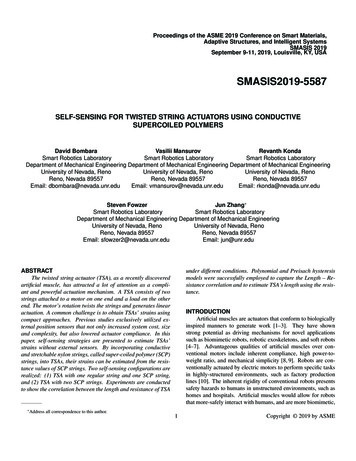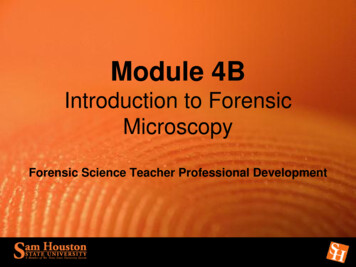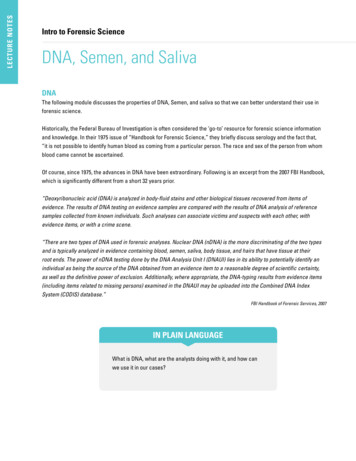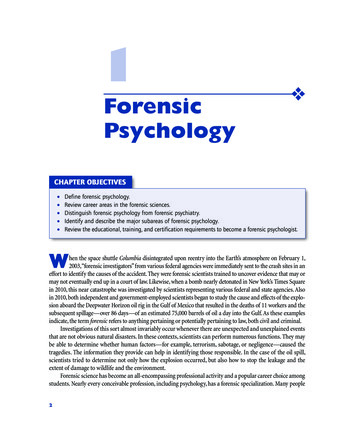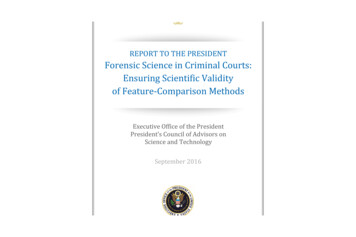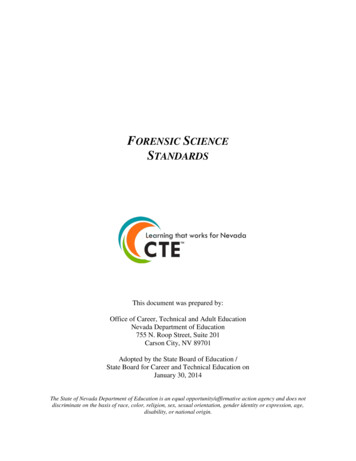
Transcription
FORENSIC SCIENCESTANDARDSThis document was prepared by:Office of Career, Technical and Adult EducationNevada Department of Education755 N. Roop Street, Suite 201Carson City, NV 89701Adopted by the State Board of Education /State Board for Career and Technical Education onJanuary 30, 2014The State of Nevada Department of Education is an equal opportunity/affirmative action agency and does notdiscriminate on the basis of race, color, religion, sex, sexual orientation, gender identity or expression, age,disability, or national origin.
FORENSIC SCIENCE STANDARDS2014NEVADA STATE BOARD OF EDUCATIONNEVADA STATE BOARD FOR CAREER AND TECHNICAL EDUCATIONElaine Wynn. PresidentAllison Serafin .Vice PresidentThad Ballard. MemberDave Cook . MemberAlexis Gonzales-Black. MemberFreeman Holbrook . MemberKevin Melcher . MemberMark Newburn . MemberRichard Stokes . MemberKamryn Mock . Student RepresentativeCTE MISSION STATEMENT:The Office of Career, Technical and Adult Education is dedicated to developing innovativeeducational opportunities for students to acquire skills for productive employment and lifelong learning.NEVADA DEPARTMENT OF EDUCATIONDale A.R. ErquiagaSuperintendent of Public InstructionSteve Canavero, Ph.D.Deputy Superintendent for Student AchievementMichael J. Raponi, DirectorOffice of Career, Technical and Adult EducationReleased: 01/30/2014Nevada CTE Standardsiii
FORENSIC SCIENCE STANDARDS2014TABLE OF CONTENTSNevada State Board of Education / Nevada Department of Education. iiiAcknowledgements / Standards Development Members / Business and Industry Validation /Project Coordinator . viiIntroduction . ixContent Standard 1.0 – Explore Foundations of Forensic Science . 1Content Standard 2.0 – Examining Legal and Ethical Issues in Forensic Science . 2Content Standard 3.0 – Explore Crime Scene Investigations . 3Content Standard 4.0 – Recognize and Implement Laboratory Fundamentals . 4Content Standard 5.0 – Explore Forensic Disciplines . 5Content Standard 6.0 – Understand Courtroom Proceedings . 6Content Standard 7.0 – Explore Forensic Specialties . 7Crosswalks and Alignments . 9Released: 01/30/2014Nevada CTE Standardsv
FORENSIC SCIENCE STANDARDS2014ACKNOWLEDGEMENTSThe development of Nevada career and technical standards and assessments is a collaborative effortsponsored by the Office of Career, Technical and Adult Education at the Department of Education and theCareer and Technical Education Consortium of States. The Department of Education relies on teachersand industry representatives who have the technical expertise and teaching experience to developstandards and performance indicators that truly measure student skill attainment. Most important,however, is recognition of the time, expertise and great diligence provided by the writing team membersin developing the career and technical standards for Forensic Science.STANDARDS DEVELOPMENT MEMBERSBryan ManoukianCarson High SchoolCarson CityChristina O’KeeffeWest Wendover High SchoolWest WendoverLori HainesFoothill High SchoolHendersonRenee RomeroWashoe County Sheriff’s OfficeRenoVernon SchultzVeterans Tribute Career Technical AcademyLas VegasLee AlbinWashoe County School District JROTCRenoEric Curtis, DetectiveSparks Police DepartmentSparksArnold Brock Jr., J.D.Truckee Meadows Community CollegeRenoScott LautzenheiserVeterans Tribute Career Technical AcademyLas VegasBUSINESS AND INDUSTRY VALIDATIONAll CTE standards developed through the Nevada Department of Education are validated by business andindustry through one or more of the following processes: (1) the standards are developed by a teamconsisting of business and industry representatives; or (2) a separate review panel was coordinated withindustry experts to ensure the standards include the proper content; or (3) the adoption of nationallyrecognized standards endorsed by business and industry. The standards also support education regardingNRS.176.0913 and biological evidence.The Forensic Science standards were validated through active participation of business and industryrepresentatives on the development team.PROJECT COORDINATORRandi Hunewill, Education Programs SupervisorHealth Science and Public SafetyOffice of Career, Technical and Adult EducationNevada Department of EducationReleased: 01/30/2014Nevada CTE Standardsvii
FORENSIC SCIENCE STANDARDS2014INTRODUCTIONThe standards in this document are designed to clearly state what the student should know and beable to do upon completion of an advanced high school Forensic Science program. These standards aredesigned for a three-credit course sequence that prepares the student for a technical assessment directlyaligned to the standards.These exit-level standards are designed for the student to complete all standards through theircompletion of a program of study. These standards are intended to guide curriculum objectives for aprogram of study.The standards are organized as follows:Content Standards are general statements that identify major areas of knowledge,understanding, and the skills students are expected to learn in key subject and career areas by the end ofthe program.Performance Standards follow each content standard. Performance standards identify the morespecific components of each content standard and define the expected abilities of students within eachcontent standard.Performance Indicators are very specific criteria statements for determining whether a studentmeets the performance standard. Performance indicators may also be used as learning outcomes, whichteachers can identify as they plan their program learning objectives.The crosswalk and alignment section of the document shows where the performance indicatorssupport the English Language Arts and the Mathematics Common Core State Standards, and the NevadaState Science Standards. Where correlation with an academic standard exists, students in the ForensicScience program perform learning activities that support, either directly or indirectly, achievement of oneor more Common Core State Standards.All students are encouraged to participate in the career and technical student organization (CTSO)that relates to their program area. CTSOs are co-curricular national associations that directly enforcelearning in the CTE classroom through curriculum resources, competitive events, and leadershipdevelopment. CTSOs provide students the ability to apply academic and technical knowledge, developcommunication and teamwork skills, and cultivate leadership skills to ensure college and career readiness.The Employability Skills for Career Readiness identify the “soft skills” needed to be successful inall careers, and must be taught as an integrated component of all CTE course sequences. These standardsare available in a separate document.The Standards Reference Code is only used to identify or align performance indicators listed inthe standards to daily lesson plans, curriculum documents, or national standards.Program NameForensic ScienceStandards Reference CodeFOSCIExample: FOSCI.2.3.4StandardsForensic ScienceReleased: 01/30/2014Content Standard2Performance Standard3Nevada CTE StandardsPerformance Indicator4ix
FORENSIC SCIENCE STANDARDSCONTENT STANDARD 1.0 :2014EXPLORE FOUNDATIONS OF FORENSIC SCIENCEPERFORMANCE STANDARD 1.1 : EXAMINE THE HISTORY OF FORENSIC SCIENCE1.1.11.1.21.1.31.1.41.1.5Define forensic scienceIdentify the major disciplines it encompassesConstruct a timeline of significant contributions in forensic scienceResearch major contributors to the field of forensic scienceRecognize and implement Locard’s Exchange PrinciplePERFORMANCE STANDARD 1.2 : UNDERSTAND THE ROLE OF FORENSIC SCIENCE IN THE CRIMINALJUSTICE SYSTEM1.2.11.2.21.2.3Differentiate between local , state, and federal agenciesSummarize roles of the law enforcement organizationsResearch duties and responsibilities of forensic science personnelPERFORMANCE STANDARD 1.3 : EXAMINE DIFFERENT TYPES OF EVIDENCE1.3.11.3.21.3.31.3.4Compare and contrast physical and testimonial evidenceIdentify legal and proper evidence collection techniquesCategorize physical evidenceEvaluate evidence for its probative value in criminal proceedingsPERFORMANCE STANDARD 1.4 : EXPLORE CAREERS IN FORENSIC SCIENCE1.4.11.4.2Investigate the variety of careers in the forensic science fieldResearch educational requirements for forensic careersReleased: 01/30/2014Nevada CTE Standards1
2014FORENSIC SCIENCE STANDARDSCONTENT STANDARD 2.0 :EXAMINING LEGAL AND ETHICAL ISSUES INFORENSIC SCIENCEPERFORMANCE STANDARD 2.1 : EXAMINE LEGAL ISSUES2.1.12.1.22.1.32.1.42.1.5Explore the Fourth Amendment and recognize legal search and seizuresModel procedures to ensure chain of custody when collecting evidenceResearch Frye, Miranda, and Daubert court casesUnderstand how landmark court cases have determined admissibility of evidence in courtroomsEmploy good practices of confidentialityPERFORMANCE STANDARD 2.2 : EXAMINE ETHICAL ISSUES IN FORENSIC SCIENCE2.2.12.2.22.2.3Define ethics, integrity, and biasResearch case studies to illustrate proper guidelinesPractice unbiased evidence collection, forensic analysis, and testimonyPERFORMANCE STANDARD 2.3 : MODEL PROFESSIONALISM2.3.12.3.22.3.32Recognize and implement a proper code of conduct for a career in the forensic fieldRecognize and implement proper etiquette for crime scene investigationsApply good communication through verbal, written and testimonial skillsNevada CTE StandardsReleased: 01/30/2014
FORENSIC SCIENCE STANDARDSCONTENT STANDARD 3.0 :2014EXPLORE CRIME SCENE INVESTIGATIONSPERFORMANCE STANDARD 3.1 : IDENTIFY AND UTILIZE CRIME SCENE strate proper procedures to secure a crime sceneIdentify the scope of a crime sceneIdentify safety hazards in crime scene investigationImplement proper safety protocolsDescribe and implement searching techniquesExamine constitutional/legal protections in crime scene investigationsIdentify and utilize information sources during an investigationPERFORMANCE STANDARD 3.2 : UTILIZE SCENE cognize and implement appropriate measurement techniqueUtilize note taking techniquesExplain procedures in crime scene photographyImplement sketching/diagramming techniquesPrepare evidence logsExplain scene reconstructionPrepare crime scene investigation reportsPERFORMANCE STANDARD 3.3 : EXAMINE EVIDENCE COLLECTION3.3.13.3.23.3.33.3.43.3.5Recognize potential evidence sourcesIdentify sources of potential contaminationApply appropriate crime scene and evidence processing techniquesRecognize and implement chain of custody procedureDemonstrate packaging and sealing techniquesReleased: 01/30/2014Nevada CTE Standards3
2014FORENSIC SCIENCE STANDARDSCONTENT STANDARD 4.0 :RECOGNIZE AND IMPLEMENT LABORATORYFUNDAMENTALSPERFORMANCE STANDARD 4.1 : EXPLORE SAFETY4.1.14.1.24.1.34.1.44.1.5Explain general lab safetyIdentify and utilize personal protective equipment (PPE)Identify biological hazardsIdentify chemical hazardsUnderstand proper disposal proceduresPERFORMANCE STANDARD 4.2 : RECOGNIZE AND UTILIZE LAB SKILLS4.2.14.2.24.2.3Distinguish appropriate measurement devices for tasksIdentify and utilize appropriate lab equipmentUnderstand contamination control proceduresPERFORMANCE STANDARD 4.3: UNDERSTAND QUALITY ASSURANCE4.3.14.3.24.3.34Explore individual certification requirementsExplore laboratory accreditation requirementsUnderstand quality control analysis proceduresNevada CTE StandardsReleased: 01/30/2014
FORENSIC SCIENCE STANDARDSCONTENT STANDARD 5.0 :2014EXPLORE FORENSIC DISCIPLINESPERFORMANCE STANDARD 5.1 : EXAMINE BIOLOGICAL EVIDENCE5.1.15.1.25.1.35.1.45.1.55.1.6Recognize types of biological evidenceDescribe methodology for current biological evidence analysis techniquesCompare and contrast presumptive and confirmatory results in biological analysisCritique the combined DNA index system (CODIS)Summarize interpretation and conclusions for biological evidence analysisCompose report for biological evidence analysisPERFORMANCE STANDARD 5.2 : EXAMINE CHEMICAL EVIDENCE5.2.15.2.25.2.35.2.45.2.5Recognize types of chemical evidenceDescribe methodology for toxicology, controlled substances and arson analysisCompare and contrast presumptive and confirmatory results in chemical analysisSummarize interpretation and conclusions for toxicology, controlled substance and arson analysisCompose reports for toxicology, controlled substance, and arson analysisPERFORMANCE STANDARD 5.3 : EXAMINE FINGERPRINT EVIDENCE5.3.15.3.25.3.35.3.45.3.55.3.65.3.7Compare and contrast latent, plastic, patent, and ink printsCompare and contrast latent print processing techniquesUnderstand photography as it applies to latent print processing and recoveryUnderstand comparison methodologyUnderstand structure of automated fingerprint identification system (AFIS)Summarize interpretation and conclusions for fingerprint evidenceCompose report for fingerprint comparisonPERFORMANCE STANDARD 5.4 : EXAMINE FIREARM AND TOOL MARK EVIDENCE5.4.15.4.25.4.35.4.45.4.5Recognize firearms and tool mark evidenceDescribe methodologies for firearm, tool mark and serial number restorationUnderstand structure of National Integrated Ballistic Information Network (NIBIN)Summarize interpretation and conclusions for firearms, tool marks and serial number restorationCompose reports for firearms, tool marks and serial number restorationPERFORMANCE STANDARD 5.5 : EXAMINE ADDITIONAL DISCIPLINES5.5.15.5.25.5.35.5.4Explore question documentsExplore shoe and tire impression evidenceExplore trace evidenceExplore digital evidenceReleased: 01/30/2014Nevada CTE Standards5
2014FORENSIC SCIENCE STANDARDSCONTENT STANDARD 6.0 :UNDERSTAND COURTROOM PROCEEDINGSPERFORMANCE STANDARD 6.1 : IDENTIFY COURTROOM PROCESSES6.1.16.1.2Identify roles and responsibilities of courtroom personnelIdentify the components of legal proceedingsPERFORMANCE STANDARD 6.2 : DESCRIBE ROLE OF THE EXPERT WITNESS6.2.16.2.26.2.36.2.46.2.56Compare and contrast qualifications of expert versus lay witnessesDescribe forensic methodology to juryDemonstrate courtroom demeanorUnderstand direct examination questioningUnderstand cross examination questioningNevada CTE StandardsReleased: 01/30/2014
FORENSIC SCIENCE STANDARDSCONTENT STANDARD 7.0 :2014EXPLORE FORENSIC SPECIALTIESPERFORMANCE STANDARD 7.1 : EXPLORE DEATH INVESTIGATION7.1.17.1.27.1.37.1.4Discuss the determination of cause and manner of deathExplore forensic pathologyCompare and contrast injury typesDistinguish post-mortem changesPERFORMANCE STANDARD 7.2 : EXPLORE FORENSIC ANTHROPOLOGY7.2.17.2.27.2.3Define anthropologyExplore the examination of skeletal remainsDevelop an anthropological profilePERFORMANCE STANDARD 7.3 : EXPLORE FORENSIC ENTOMOLOGY7.3.17.3.27.3.3Discuss the determination of post-mortem intervalIdentify entomological collection procedureIdentification of species using a variety of sourcesPERFORMANCE STANDARD 7.4 : EXPLORE FORENSIC ODONTOLOGY7.4.17.4.2Understand dental identificationCritique bite mark analysisPERFORMANCE STANDARD 7.5 : EXPLORE FORENSIC PSYCHOLOGY7.5.17.5.2Discuss forensic psychology in criminal investigationsExplore psychological/criminal profilingReleased: 01/30/2014Nevada CTE Standards7
2014FORENSIC SCIENCE STANDARDSThis Page was Intentionally Left Blank8Nevada CTE StandardsReleased: 01/30/2014
FORENSIC SCIENCE STANDARDS2014CROSSWALKS AND ALIGNMENTS OFFORENSIC SCIENCE STANDARDSAND THE COMMON CORE STATE STANDARDS,THE NEVADA SCIENCE STANDARDS,AND THE COMMON CAREER TECHNICAL CORE STANDARDSCROSSWALKS (ACADEMIC STANDARDS)The crosswalk of the Forensic Science Standards shows links to the Common Core State Standardsfor English Language Arts and Mathematics and the Nevada Science Standards. The crosswalkidentifies the performance indicators in which the learning objectives in the Forensic Science programsupport academic learning. The performance indicators are grouped according to their contentstandard and are crosswalked to the English Language Arts and Mathematics Common Core StateStandards and the Nevada Science Standards.ALIGNMENTS (MATHEMATICAL PRACTICES)In addition to correlation with the Common Core Mathematics Content Standards, many performanceindicators support the Common Core Mathematical Practices. The following table illustrates thealignment of the Forensic Science Standards Performance Indicators and the Common CoreMathematical Practices. This alignment identifies the performance indicators in which the learningobjectives in the Forensic Science program support academic learning.CROSSWALKS (COMMON CAREER TECHNICAL CORE)The crosswalk of the Forensic Science Standards shows links to the Common Career Technical Core.The crosswalk identifies the performance indicators in which the learning objectives in the ForensicScience program support the Common Career Technical Core. The Common Career Technical Coredefines what students should know and be able to do after completing instruction in a program ofstudy. The Forensic Science Standards are crosswalked to the Law, Public Safety, Corrections &Security Career Cluster and the Law Enforcement Services Career Pathway.Released: 01/30/2014Nevada CTE Standards9
2014FORENSIC SCIENCE STANDARDSThis Page was Intentionally Left Blank10Nevada CTE StandardsReleased: 01/30/2014
FORENSIC SCIENCE STANDARDS2014CROSSWALK OF FORENSIC SCIENCE STANDARDSAND THE COMMON CORE STATE STANDARDSCONTENT STANDARD 1.0: EXPLORE FOUNDATIONS OF FORENSIC SCIENCEPerformanceIndicators1.1.4Common Core State Standards and Nevada Science StandardsEnglish Language Arts: Reading Standards for Literacy in Science and Technical SubjectsRST.11-12.7Integrate and evaluate multiple sources of information presented in diverse formats andmedia (e.g., quantitative data, video, multimedia) in order to address a question or solvea problem.RST.11-12.9Synthesize information from a range of sources (e.g., texts, experiments, simulations)into a coherent understanding of a process, phenomenon, or concept, resolvingconflicting information when possible.English Language Arts: Speaking and Listening StandardsSL.11-12.1aCome to discussions prepared having read and researched material under study;explicitly draw on that preparation by referring to evidence from texts and otherresearch on the topic or issue to stimulate a thoughtful, well-reasoned exchange ofideas.SL.11-12.2Integrate multiple sources of information presented in diverse formats and media (e.g.,visually, quantitatively, orally) in order to make informed decisions and solveproblems, evaluating the credibility and accuracy of each source and noting anydiscrepancies among the data.SL.11-12.41.1.5Present information, findings, and supporting evidence, conveying a clear and distinctperspective, such that listeners can follow the line of reasoning, alternative or opposingperspectives are addressed, and the organization, development, substance, and style areappropriate to purpose, audience, and a range of formal and informal tasks.English Language Arts: Writing Standards for Literacy in Science and Technical SubjectsWHST.11-12.7 Conduct short as well as more sustained research projects to answer a question(including a self-generated question) or solve a problem; narrow or broaden the inquirywhen appropriate; synthesize multiple sources on the subject, demonstratingunderstanding of the subject under investigation.English Language Arts: Reading Standards for Literacy in Science and Technical SubjectsRST.11-12.9Synthesize information from a range of sources (e.g., texts, experiments, simulations)into a coherent understanding of a process, phenomenon, or concept, resolvingconflicting information when possible.English Language Arts: Writing Standards for Literacy in Science and Technical SubjectsWHST.11-12.8 Gather relevant information from multiple authoritative print and digital sources, usingadvanced searches effectively; assess the strengths and limitations of each source interms of the specific task, purpose, and audience; integrate information into the textselectively to maintain the flow of ideas, avoiding plagiarism and overreliance on anyone source and following a standard format for citation.Released: 01/30/2014Nevada CTE Standards11
20141.2.1FORENSIC SCIENCE STANDARDSEnglish Language Arts: Reading Standards for Literacy in Science and Technical SubjectsRST.11-12.7Integrate and evaluate multiple sources of information presented in diverse formats andmedia (e.g., quantitative data, video, multimedia) in order to address a question or solvea problem.RST.11-12.91.2.21.2.3Synthesize information from a range of sources (e.g., texts, experiments, simulations)into a coherent understanding of a process, phenomenon, or concept, resolvingconflicting information when possible.English Language Arts: Speaking and Listening StandardsSL.11-12.4Present information, findings, and supporting evidence, conveying a clear and distinctperspective, such that listeners can follow the line of reasoning, alternative or opposingperspectives are addressed, and the organization, development, substance, and style areappropriate to purpose, audience, and a range of formal and informal tasks.English Language Arts: Writing Standards for Literacy in Science and Technical SubjectsWHST.11-12.8 Gather relevant information from multiple authoritative print and digital sources, usingadvanced searches effectively; assess the strengths and limitations of each source interms of the specific task, purpose, and audience; integrate information into the textselectively to maintain the flow of ideas, avoiding plagiarism and overreliance on anyone source and following a standard format for citation.English Language Arts: Reading Standards for Literacy in Science and Technical SubjectsRST.11-12.2Determine the central ideas or conclusions of a text; summarize complex concepts,processes, or information presented in a text by paraphrasing them in simpler but stillaccurate terms.English Language Arts: Writing Standards for Literacy in Science and Technical SubjectsWHST.11-12.8 Gather relevant information from multiple authoritative print and digital sources, usingadvanced searches effectively; assess the strengths and limitations of each source interms of the specific task, purpose, and audience; integrate information into the textselectively to maintain the flow of ideas, avoiding plagiarism and overreliance on anyone source and following a standard format for citation.English Language Arts: Reading Standards for Literacy in Science and Technical SubjectsRST.11-12.7Integrate and evaluate multiple sources of information presented in diverse formats andmedia (e.g., quantitative data, video, multimedia) in order to address a question or solvea problem.RST.11-12.8Evaluate the hypotheses, data, analysis, and conclusions in a science or technical text,verifying the data when possible and corroborating or challenging conclusions withother sources of information.English Language Arts: Speaking and Listening StandardsSL.11-12.1aCome to discussions prepared, having read and researched material under study;explicitly draw on that preparation by referring to evidence from texts and otherresearch on the topic or issue to stimulate a thoughtful, well-reasoned exchange ofideas.SL.11-12.2Integrate multiple sources of information presented in diverse formats and media (e.g.,visually, quantitatively, orally) in order to make informed decisions and solveproblems, evaluating the credibility and accuracy of each source and noting anydiscrepancies among the data.SL.11-12.4Present information, findings, and supporting evidence, conveying a clear and distinctperspective, such that listeners can follow the line of reasoning, alternative or opposingperspectives are addressed, and the organization, development, substance, and style areappropriate to purpose, audience, and a range of formal and informal tasks.English Language Arts: Writing Standards for Literacy in Science and Technical SubjectsWHST.11-12.7 Conduct short as well as more sustained research projects to answer a question(including a self-generated question) or solve a problem; narrow or broaden the inquirywhen appropriate; synthesize multiple sources on the subject, demonstratingunderstanding of the subject under investigation.12Nevada CTE StandardsReleased: 01/30/2014
FORENSIC SCIENCE STANDARDS1.3.11.3.42014English Language Arts: Reading Standards for Literacy in Science and Technical SubjectsRST.11-12.9Synthesize information from a range of sources (e.g., texts, experiments, simulations)into a coherent understanding of a process, phenomenon, or concept, resolvingconflicting information when possible.English Language Arts: Speaking and Listening StandardsSL.11-12.1aCome to discussions prepared having read and researched material under study;explicitly draw on that preparation by referring to evidence from texts and otherresearch on the topic or issue to stimulate a thoughtful, well-reasoned exchange ofideas.English Language Arts: Writing Standards for Literacy in Science and Technical SubjectsWHST.11-12.8 Gather relevant information from multiple authoritative print and digital sources, usingadvanced searches effectively; assess the strengths and limitations of each source interms of the specific task, purpose, and audience; integrate information into the textselectively to maintain the flow of ideas, avoiding plagiarism and overreliance on anyone source and following a standard format for citation.English Language Arts: Reading Standards for Literacy in Science and Technical SubjectsRST.11-12.7Integrate and evaluate multiple sources of information presented in diverse formats andmedia (e.g., quantitative data, video, multimedia) in order to address a question or solvea problem.RST.11-12.91.4.1Synthesize information from a range of sources (e.g., texts, experiments, simulations)into a coherent understanding of a process, phenomenon, or concept, resolvingconflicting information when possible.English Language Arts: Writing Standards for Literacy in Science and Technical SubjectsWHST.11-12.7 Conduct short as well as more sustained research projects to answer a question(including a self-generated question) or solve a problem; narrow or broaden the inquirywhen appropriate; synthesize multiple sources on the subject, demonstratingunderstanding of the subject under investigation.English Language Arts: Reading Standards for Literacy in Science and Technical SubjectsRST.11-12.7Integrate and evaluate multiple sources of information presented in diverse formats andmedia (e.g., quantitative data, video, multimedia) in order to address a question or solvea problem.RST.11-12.9Synthesize information from a range of sources (e.g., texts, experiments, simulations)into a coherent understanding of a process, phenomenon, or concept, resolvingconflicting information when possible.English Language Arts: Writing Standards for Literacy in Science and Technical SubjectsWHST.11-12.7 Conduct short as well as more sustained research projects to answer a question(including a self-generated question) or solve a problem; narrow or broaden the inquirywhen appropriate; synthesize multiple sources on the subject, demonstratingunderstanding of the subject under investigation.Released: 01/30/2014Nevada CTE Standards13
20141.4.2FORENSIC SCIENCE STANDARDSEnglish Language Arts: Reading Standards for Literacy in Science and Technical SubjectsRST.11-12.7Integrate and evaluate multiple sources of information presented in diverse formats andmedia (e.g., quantitative data, video, multimedia) in order to address a question or solvea problem.RST.11-12.9Synthesize information from a range of sources (e.g., texts, experiments, simulations)into a coherent understanding of a process, phenomenon, or concept, resolvingconflicting information when possible.English Language Arts: Speaking and Listening StandardsSL.11-12.1aCome to discussions prepared, having read and researched material under study;explicitly draw on that preparation by referring to evidence from texts and otherresearch on the topic or issue to stimulate a thoughtful, well-reasoned exchange ofideas.SL.11-12.2Integrate multiple sources of information presented in diverse formats and media (e.g.,visually, quantitatively, orally) in order to make informed decisions and solveproblems, evaluating the credibility and accuracy of each source and noting anydiscrepancies among the data.SL.11-12.
The Forensic Science standards were validated throughactive participation of business and industry representatives on the development team. P ROJECT C OORDINATOR Randi Hunewill, Education Programs Supervisor Health Science and Public Safety Office of Career, Techni

